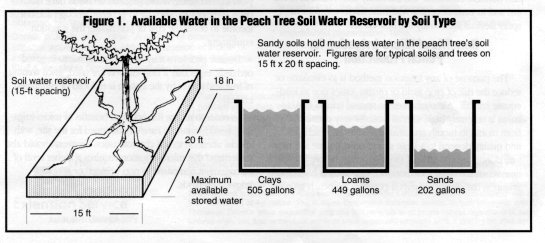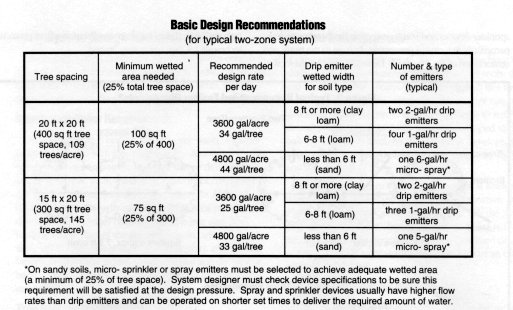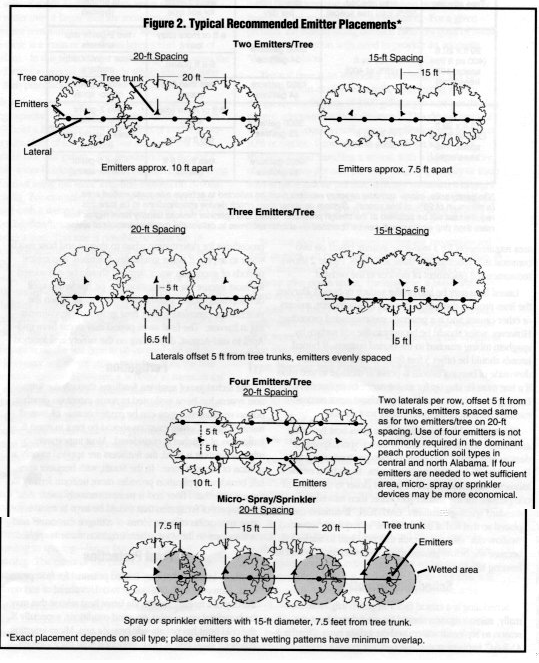
- Home
- Managing An Irrigation System
- Planning System Hardware
- Farm Irrigation Systems & Cost Analysis
- Water Resource Development
- Micro Irrigation Handbook
- Related Links
Commercial Peaches
Larry M. Curtis, Extension Agricultural Engineer
Arlie A. Powell, Extension Horticulturist
Ted W. Tyson, Extension Agricultural Engineer
Alabama ranks as one of the most important peach growing states in the Southeast, with about 9,000 acres of orchards annually producing 15 to 30 minion pounds of top quality peaches with a market value of up to $15 million. Over two-thirds of the annual crop is produced in central Alabama (mainly Chilton and Autauga counties), with the Tennessee Valley area accounting for about one fourth. Significant peach production also comes from South Alabama, where acreage has been increasing.
Alabama peach growers began installing micro-irrigation systems in the late 1970s and early 1980s. Micro- has proven effective in peach production, and systems are being installed in increasing numbers of peach orchards in Alabama. Peaches perform best in soils with one to two feet of sandy loam underlaid with a friable, red clay loam or clay subsoil, most often found in central Alabama. Systems using individual drip emitters are well suited for this soil type, as well as for the clay loam soils also found in central and northern Alabama. On the sandy soils found in southem and in parts of central Alabama, micro-sprinkler or spray devices are usually the best choice.
Benefits of Micro-Irrigation for Peach Production
The purpose of any irrigation method is to eliminate or reduce the risk of crop yield or quality losses due to inadequate rainfall. Although average annual rainfall in Alabama is relatively high, rainfall patterns vary considerably from month to month and season to season. Peach yield and quality depend to a large extent on adequate soil moisture during the critical final swell stage just before harvest, a time when the chance of drought in Alabama is high. Thus irrigation has significant payoff potential for peach growers.
Other irngation benefits include:
- Survival rate for newly planted trees is higher compared to plantings that are not watered.
- In newly established orchards, irrigated trees have increased growth rate and reach production size sooner, particularly if drought occurs during the first two years. Irrigated trees are capable of producing larger crops, mainly because of a greater quantity of fruiting wood.
- In dry years, irrigated trees usually ripen fruit at least 4 and sometimes 7 days ahead of non-irrigated peaches.
- Providing adequate soil moisture into the fall encourages development of abundant, vigorous fruit buds for next year's crop and ensures that trees will be less susceptible to winter damage and stress-related short life problems.
In addition to providing all the above benefits, micro-irrigation has further advantages over other irrigation methods:
- Since micro- systems operate at lower pressures than do overhead sprinkler systems, energy use and both operating and capital costs are lower. In drought years, quality and yield differences in micro-irrigated orchards have often been sufficient in one year to generate enough additional income to cover the cost of purchasing the irrigation equipment.
- Disease problems may be reduced in micro-irrigated orchards, especially if drip emitters are used, since wetting of fruit and leaves by the system is reduced or eliminated entirely.
In order to realize the potential benefits of micro-irrigation, systems must be carefully designed for the site, with special attention to soil characteristics. Growers should also understand that micro-irrigation requires a higher level of management compared to non-irrigated or sprinkler irrigated orchards.
System Design for Peach Orchards
Successful system design for peaches requires consideration of the characteristics of peach trees, including especially their root systems and water requirements, and the water holding and distribution characteristics of the soil.
Peach Tree Water Requirements
Peach trees thrive best on good quality water, with pH from 5.5 to 8 and with low soluble salts. Amounts of water needed vary depending on the stage of tree development and time of year. Peak water needs usually occur during hot weather in June, July and early August. In Alabama, this peak need is usually around 4,800 gallons per acre per day. Amount of water used depends on tree size, crop load, leaf area, time of the growing season, amount of sunlight, wind, relative humidity, and other plant and climatic factors. As the main growth cycle subsides and the crop is harvested, the demand for water uptake by the tree drops markedly.
Tree Root Systems
Peach tree roots will extend horizontally wherever favorable soil and moisture conditions exist. In Alabama, with plentiful annual rainfall, roots often extend well beyond the limb, reach, and may cover 100% of the orchard surface area. Thus in irrigated orchards trees normally do not concentrate roots in or become dependent on an irngated area under the tree, but will also make use of rainfall water stored outside the irrigated zone. However, peach trees are shallow-rooted, with 90% of the feeder roots in the upper 18 inches of soil. This means that in a dry period peach trees will go into drought stress sooner than would a deeper-rooted species. Irrigation system design must take this characteristic into consideration.
The Soil Water Reservoir
The peach tree must get all the water it uses from the shallow soil layer containing the active feeder roots, the soil water reservoir. Following a rain, a peach tree draws available water from this reservoir. If no further rain (or irngation) refills the reservoir, the tree will begin to suffer drought stress when available water has dropped to about half the maximum level. As drought stress develops, fruit yield and quality may be reduced before the tree shows any visible signs of stress.
Since the peach tree's soil water reservoir is shallow, the water-holding capacity of the soil is very important. As Figure 1 shows, sandy soils store less than half the amount of available water that clay and loam type soils hold. This means that in a dry period an unirrigated orchard on sandy soil will suffer drought stress much sooner than an orchard on loam or clay soil.

Soil Factors in System Design
The water-holding capacity and related water movement characteristics of soils are very important in micro-irrigation design. Water deposited on the surface by a drip emitter will spread horizontally in clay loam and loam soils much farther than it will in sandy soil (see Figure 1 in Circular ANR-645, System Design). Typical "wetted widths" for different soils are:
Clay loam--8 to 10 feet (4-5 ft radius)
Loam-6 to 8 feet (3-4 ft radius)
Sand-Less than 6 feet (under 3 ft radius)
Sandy loam and clay loam soils that have the greatest "wetted width" (horizontal movement) are best suited to drip irrigation techniques. On these sods, water from drip emitters will spread far enough horizontally so that an adequate amount will be held in the tree's root zone. When the drip emitter wetted width is less than 6 feet, as on the sandy soils of south Alabama, rnicro- spray devices that throw water over a larger area are more practical. Drip emitters are sometimes used on sandy soils, however, where there is a loam or clay/loam layer within a foot of the surface. In this situation the underlying layer causes the applied water to spread horizontally within the root zone rather than percolating down below the roots.
Soils with greater wetted width also have higher waterholding capacity. For example, a typical sandy clay loam soil will hold a little more than one gallon of available water per cubic foot of soil, while a fine sand soil will hold only about one half gallon. The importance of the soil's available water-holding capacity can be seen by comparing the effects of using the same irrigation method on two different soils. For example, in a typical situation on a clay loam soil with a wetted width of 8 feet a micro- system may use two 2-gallon/hour drip emitters to deliver 34 gallons per day to a tree. This rate is possible because the 18 inches of soil underneath the wetted width of these emitters typically can hold around 160 gallons of available water. However, on a sandy soil with a wetted width of 5 feet the reservoir underneath the same emitters would have a maximum holding capacity of only about 29 gallons. Therefore this application rate with these same emitters would not be possible on the sandy soil.
Information on the soil type at an orchard site can be found in county soil survey maps available from the Soil Conservation Service. However, it is better to measure the actual wetted width at your orchard site than to rely on typical wetted width figures for a given soil type. Circular ANR-645, System Design, explains a simple field test to determine the soil's wetted width. To provide a reliable basis for design decisions, the test should be repeated at several spots in the orchard site.
System Sizing
Peach trees typically are pruned so that about 75% of the orchard soil surface is covered by the noon shadow of the tree canopies. Since such pruning is done regardless of tree spacing, both size and number of trees in an orchard vary according to spacing-larger but fewer trees with wider spacing. The effect of this practce is that while the water requirement per tree varies (larger trees need more water), the water requirement per acre remains the same.
Most micro-irrigation systems in Southeastern peach orchards are designed not to supply the entire water requirement of the trees but to supplement rainfall. That is, the irrigation system extends the number of days the trees can go between rainfalls before soil moisture is depleted. This "deficit irrigation" does have some risks if an extended, multi-month drought occurs. However, the deficit technique has proven successful in Alabama practically every year since micro-irrigation has been used. For a given orchard, the system sizing decision balances costs of installation and operation with need to provide an adequate "drought cushion."
The soil type is an important consideration. For orchards on loam or clay loam soils, an irrigation system design application rate of 3600 gallons per acre per day has proven adequate for most situations. This design amount takes into account typical micro- application efficiencies of 90% or higher. Growers with orchards on sandy soils should consider installing a system with a design capacity of 4800 gallons per acre per day. Irrigating on clay or loam soils at 3600 gallons per acre typically maintains a drought cushion of up to a month or more. However, orchards on sandy soils irrigated at this rate may experience drought stress in less than two weeks.
Systems should be designed so that the recommended daily amount can be delivered to the orchard in less than 24 hours, to provide a safety margin for maintenance and catch-up after down times. For example, a two-zone orchard system designed to supply 3600 gallons per acre per zone in 9 hours will allow a 3-hour safety margin per zone. Also, this system would be able to supply the entire peak water requirement in 12 hours, allowing the system to cope with extended drought.
Type, Number and Placement of Emitters
The type of irrigation device (drip or spray) and their number and placement depend on:
1. Amount of water to be applied.
2. Flow rates of the devices.
3. Operating time of the system.
4. The area required to be wetted, and the available storage capacity of the soil (soil type).
Achieving an adequate total wetted area is a key requirement. As explained above, the area that win be wetted depends on both the type of emitter and the soil type. As a rule, the area wetted should be at least 25% of the total tree area. A design with 50% coverage gives a wider safety factor. For example, for 20 ft x 20 ft spacing, total tree area will be 400 square feet and the wetted area should be a minimum of 100 square feet (25% of 400).
The table below shows basic design recommendations, including the type and number of emitters (drip or spray) typically used to meet minimum water and wetted area requirements for a two-zone system, based on two common tree spacings and three soil types. Figure 2 shows recommended placement of devices in the orchard.

Lateral lines may be laid on the surface or buried. Burying the lines protects them from damage by equipment, rodents or other causes, and is a generally recommended procedure. However, water should be brought to the soil surface by spaghetti tubing attached to the buried emitters. If buried, laterals should be offset 5 feet from the tree trunk. The downside of burying laterals is possible damage to tree roots if a line must be dug up for maintenance or replacement. Burying lateral lines in an existing orchard is not recommended because of the potential for root damage.
Placing lateral lines on the surface gives best flexibility and access, and is well suited for micro- spray/sprinkler devices and paired drip emitters (two per tree), since the line can be laid against the tree trunks. In orchard establishment, drip emitters can be placed closer to the trees, to compensate for the smaller root zone, then moved to standard spacings at maturity. CAUTION: If emitters are placed so that soil at the tree trunk is frequently saturated, a "wallow out" effect can result that may lead to winter kill because the below ground trunk and roots are exposed to freezing temperatures.

Scheduling Irrigation
Scheduling is a critical factor in peach irrigation. Normally, micro-irrigation should be used throughout the season to replenish water used on a daily basis. Circular ANR-647 explains water management considerations and procedures for determining when to irrigate and how much water to apply. If water availability is limited, two critical periods of maximum water demand should be considered for most intense use of irrigation: the pit hardening (cell development) stage, and the final swell stage, when the peaches are completing their final growth cycle, culminating at harvest. The final swell period may occur from mid-April to mid-August, depending on the variety and location in the state.
Fertigation
The technique of applying fertilizers through the irrigation system has been evaluated to some extent on peaches, but no recommendations can be made because of limited research data. Certain cautions should be kept in mind if fertigation of peaches is considered. Most importantly, when fertigation is used, the fertilizers are applied to only a portion of the root zone. In the South, with frequent rainfall, broadcast application provides more uniform fertility to the entire orchard floor and is more commonly used. Another aspect of fertigation that should be kept in mind is that application of some forms of nitrogen can cause acid soil to form in the zone where irrigation water is applied.
Frost Protection
Micro-irrigation has very limited potential for frost protection. However, irrigating one or two days ahead of and on the day of a freeze can provide latent heat release that may be beneficial under calm, no-wind conditions, especially if the cold front has not already brought rain. Micro-irrigation has been evaluated in citrus in Florida with micro- spray/sprinkler devices and some protection has been provided, particularly in terms of preventing damage to the trunk and center limbs of the tree itself. However, data available at this time on the potential for micro-irrigation as a frost protection technique for peaches is very limited. I
References
Boswell, M.J. 1990. Micro-Irrigation Design Manual. James Hardie Irrigation Co., El Cajon CA.
Crocker, T.F. and G.W. Krewer. 1988. Peach irrigation in the southeastern USA. The Peach, ed. N.F. Childers and W.B. Sherman, Horticultural Publications, Gainesville FL.
Daniell, J.W. 1980. Trickle irrigation of peaches. Fruit South May 1980:4-7.
Daniell, J.W. 1981. Scheduling drip irrigation using pan evaporation. Pecan South 8(4):19-21.
Daniell, J.W. 1982. Effect of trickle irrigation on the growth and yield of "Loring" peach trees. J. of Horticultural Science 57(4):393-399.
Daniell, J.W. 1988. Scheduling drip irrigation using pan evaporation. The Peach, ed. N.F. Childers and W.B. Sherman, Horticultural Publications, Gainesville FL.
Dozier, W.A., Jr. et al. 1984. A method of determining irrigation application rates and the evaluation of trickle irrigation on peaches in Alabama. Proceedings, Alabama Fruit & Vegetable Growers Association 5:38-46.
Harrison, K.A. 1989. Irrigation for peaches. Peach Production Handbook, ed. S.C. Myers, Georgia Agricultural Experiment Station Handbook 1, University of Georgia
Knowles, J.W. et al. 1985. Trickle irrigation of peaches speeds growth of young trees and boosts yields of bearing age trees. Highlights of Agricultural Research 32(2)3, Alabama Agricultural Experiment Station, Auburn University.
Lyons, C.G., ed. 1988. Texas Peach Handbook. Texas Agricultural Extension Service, Texas Agricultural Experiment Station, College of Agriculture, Texas A & M University System.
NOAA/National Weather Service, SE Ag Weather Service Center, weather data base.
Privette, C.V. Private communication, 1986.
Sneed, R.E. Drip irrigation for small fruits and tree fruits, unpublished presentation, 1988.
Publication No.Micro Irrigation Handbook ANR-661 |
Feb. 1999 |
Larry M. Curtis, Extension Agricultural Engineer, Professor, Biosystems and Agricultural Engineering, Arlie A. Powell, Extension Horticulturist, and Ted W. Tyson, Extension Agricultural Engineer, Associate Professor, Biosystems and Agricultural Engineering. |
Issued in furtherance of Cooperative Extension work in agriculture and home economics, Acts of May 8 and June 30, 1914, and other related acts, in cooperation with the U.S. Department of Agriculture. The Alabama Cooperative Extension System (Alabama A&M University and Auburn University) offers educational programs, materials, and equal opportunity employment to all people without regard to race, color, national origin, religion, sex, age, veteran status, or disability.
This document is author-produced (unedited).

 Menu
Menu


